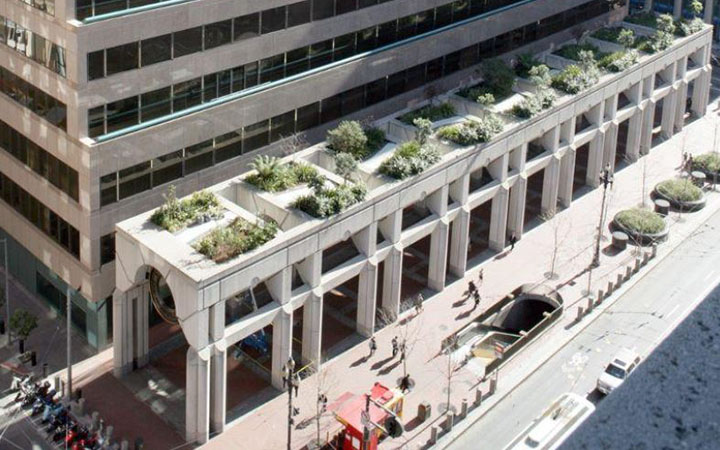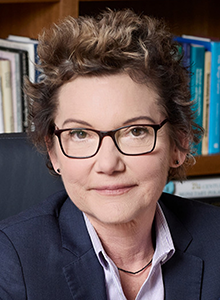Federal Reserve Bank of San Francisco
updated May 2021
The Federal Reserve Bank of San Francisco is led by president and CEO Mary C. Daly. The Twelfth Federal Reserve District, headquartered in San Francisco, includes Alaska, Arizona, California, Hawaii, Idaho, Nevada, Oregon, Utah, and Washington. The San Francisco Fed has branch locations in Los Angeles, Portland, Seattle, and Salt Lake City, and also serves American Samoa, Guam, and the Commonwealth of the Northern Mariana Islands.

Exterior of the Federal Reserve Bank of San Francisco building
©Federal Reserve Bank of San Franciscoby Federal Reserve Bank of San Francisco staff
The San Francisco Fed and the West: Reinventions and Reflections
The geographical region making up the Twelfth Federal Reserve District stands out dramatically on any map—1.4 million square miles, or 37 percent of the nation’s area. The evolution of the people and activity within the Twelfth District is an equally powerful yet multi-layered story, one that inspires astonishment and encourages reflection.
Everything began with one critical question: where would the District’s headquarters be located, across the vast western region of possibility? Seattle, Portland, and Los Angeles were strong contenders, but San Francisco—the financial center of the West since the Gold Rush—was the logical choice. The decision to locate the Twelfth District Reserve Bank headquarters there was announced in April 1914, and the San Francisco Fed started business in November of that year in rented offices with a staff of 21 people.
Setting the Stage for Growth
When the San Francisco Fed was founded, the seven western states it served were considered the American frontier. In its early years, the Bank was tightly woven with the West’s banking industry. Its main jobs were to supply currency, clear checks, and provide credit to banks in its territory. The seven states that initially comprised the Twelfth District—Arizona, California, Idaho, Nevada, Oregon, Utah, and Washington—had 1,733 banks and made up roughly 6% of all banks in the United States in 1913. Although this constituted a small percentage of the country’s financial intermediaries, banking activity had nevertheless been growing rapidly.
One distinctive innovation in many western states was their reliance on branch banking, pioneered to better serve the needs of the population. Branching was an effective means of transferring money between regions of a state where demand was high in one locality and low in another, creating the model familiar to us now. Within a few years, the San Francisco Fed established branches in Spokane (1917—later consolidating with Seattle in 1938), Seattle (1917), Portland (1917), Salt Lake City (1918), and Los Angeles (1920) to work with the banks in those regions.
This is where we came from: one hundred years ago, the economies of the seven states of the Twelfth District were based almost wholly on what its inhabitants wrested from the land. As the San Francisco Fed’s first Annual Report noted in 1915: “This district is enormously rich in natural resources and surpasses in variety of products.” Just a few years before the Federal Reserve Organizing Committee was contemplating District boundaries, with stakeholders across the nation, 49% of the nation’s gold, 67% of its silver, 57% of its copper, and 61% of its lead were produced in the Twelfth District.
It was the boldness of our entrepreneurs and workers that pushed our western states to thrive economically. The stewardship of these resources, and the impact of these early choices, are issues we still contend with today and have far-reaching economic and environmental impacts.
Yet, as we supplied the nation with the output from our farms, mines, forests, and oil fields, we didn’t manufacture much of anything. In 1909, the value of Twelfth District manufactured products equaled only one-third of the output of New York City’s factories.
From a Manufacturing Force to a Global Technology Hub
Our profile changed dramatically as we went through our first reinvention, a shift that culminated in the decades after World War II. Hydroelectric power, a concentration of engineering know-how, and the burgeoning growth of Western markets fueled a nascent factory network, turning our region into a manufacturing powerhouse. The region’s largest state, California, led the way, starting with food processing and oil refining, and then expanding into a broad range of light and heavy manufacturing. As economic historian Paul Rhode wrote: “What had been an unimportant industrial location in 1900 became the nation’s number one manufacturing state by 1977.”
This laid the groundwork for our second reinvention—a shift to a service and knowledge-based economy. As the forces of globalism swept the world in recent decades, manufacturing migrated to the developing world. Production in sectors such as aviation and information technology dwindled in our District. At the same time, we cemented our status as a center of research, engineering, and design in those sectors. And our location on the Pacific Rim connects us through trade with the emerging industrial and technological powers of Asia.
The rise of the Internet, with its astonishing capacity to disrupt and reshape most areas of life, has added new momentum to our latest reinvention. Thanks to our existing tech-sector base, the presence of leading research institutions, a concentration of venture capital, and a culture of innovation, we were positioned to take advantage of this revolutionary technology. In 1996, we established one of the first public web site presences in the Federal Reserve System, a symbol of our commitment to communication and transparency as a public service organization. By early 1998, the Twelfth District was already piloting two important web applications: cash services and check image retrieval.
Our Focus on People and Opportunity
Across much of our region, informality, a rapid pace of innovation, and diversity are woven into the fabric of the way we do business. Many of these values shape the strategy of the Twelfth District as an organization and how our employees show up every day to meet our mission and pursue our vision of being a premier public service organization.

Throughout the Twelfth District’s history of dynamic growth and reinvention, our people have been at the heart of that change. They have embodied our commitment to unlock potential and create opportunity for people across our District.
- Jacque Banks joined the San Francisco Head Office in 1966 as a messenger girl, also known as a “tube girl.” As a busy working mother, Jacque continued to pursue professional development, taking college courses while working, and eventually moved up to be a group manager in the Statistics Department, retiring after four decades of service.
- The Los Angeles Branch Board of Directors was one of the first places the Federal Reserve started to better reflect the communities we serve, appointing the first African-American board member, Norman B. Houston, in 1968 and the first woman, Ruth Handler, in 1972.
- In June 2011, to show support for the LGBTQ community and promote awareness of diversity and equality, we first raised the rainbow flag on top of the San Francisco and Los Angeles office buildings, and continue to do so. Other Twelfth District branches feature Pride displays in employee areas. It has also become a tradition to form a Banner of Love, a human LGBT Pride banner.
Our focus on people extends to our commitment to being an accessible, community-engaged Bank that listens to, learns from, and reflects the communities we serve. That means understanding the economic realities people are facing and how our policy is affecting their lives and livelihoods. Millions of people in the West have not benefited from the economic changes of recent decades. Research the San Francisco Fed published in 2021 revealed that inequities across the United States are translating into real economic losses that stifle growth, capacity, and resilience by leaving millions of people on the sidelines, underutilizing skills, and missing opportunities for innovation. Gaps in economic opportunity are costing the U.S. nearly $3 trillion per year in lost economic output, and $70 trillion over the last 30 years. The cost of these gaps continues to rise. To help our economy—and our country—reach its full potential, as a Reserve Bank we are using our tools and mandates to support a healthy economy that works for everyone.
The story of the San Francisco Fed is the story of how the world has changed since 1914, and how we have evolved with it, always striving to meet our mission and serve our remarkable District—which today is the largest and most diverse in the Federal Reserve System. Our territory has expanded beyond the Arctic Circle and across the Pacific to include Alaska, Hawaii, Guam, and the Mariana Islands. We opened the Phoenix Cash Processing Center in 2001 to serve the needs of the area and the people in it, creating the first Federal Reserve entity of its kind at that time built specifically to store currency. The Twelfth District now encompasses 21% of the nation’s population and is a global leader in cutting-edge industries including digital technology, biotechnology, and renewable energy.
As we face new challenges and changes as a society, we look back on how our region has changed since our founding, and the opportunities and consequences of growth. And as we look ahead, we are committed to supporting an economy that works for everyone—promoting innovation, accessibility, and diversity while being a force for inclusive economic progress in our region.
Written by the Federal Reserve Bank of San Francisco as of September 13, 2021. See disclaimer.


